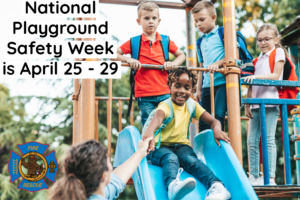National Playground Safety Week is April 25 – 29, 2022
Annually, more than 200,000 children, visit emergency rooms due to playground-related
injuries. Of those injuries, the vast majority (79%) are fall-related and account for 90% of the
most severe playground injuries states BrainLine, a national multimedia project offering
information and resources about preventing, treating, and living with TBI (Traumatic Brain
Injury). TBI is just one of the numerous and severe injuries that occur on playgrounds. Other
injuries sustained on playgrounds are fractures, internal injuries, concussions, dislocations,
and amputations. Although the majority (76%) of all injuries occur on public playgrounds,
23% occur on home playground equipment. Monkey bars and climbing equipment contribute
to 40% of playground injuries. Experts recommend removing this equipment from playground
areas because it’s dangerous.
Children not only experience severe injuries but also die playing on playground equipment;
fifteen children die, annually, from playground equipment. Falls and head injuries account for
the majority of playground-related injuries and fatalities, but the primary cause (58%) is
strangulation from clothing. Strangulation occurs when a child’s clothing, drawstrings, rope,
or jewelry are caught on the equipment. Although playground-related injuries are
preventable, they still occur due to the lack of or improper supervision — a major contributor
(45%) of playground-related injuries states Safe Kids Worldwide.
National Playground Safety Week begins April 25th – April 29th; sponsored by the National
Program for Playground Safety (NPPS). This annual event is a reminder to parents,
grandparents, caregivers, teachers, camp counselors, and others to focus on children’s
outdoor play environments due to children being vulnerable to playground-related injuries
and fatalities.
To keep your child safe, on the playground, start by implementing the S.A.F.E
Factors and Adult & Kid Safety Checklists to properly maintain a safe playground atmosphere:
S.A.F.E.
• Provide proper supervision of children on playgrounds.
• Design age-appropriate playgrounds.
• Provide proper fall surfacing under and around playgrounds.
• Properly maintain playground equipment.
Adult Safety Checklist:
• Adult presence is needed to watch for potential hazards.
• Remove jewelry, ropes, and strings on clothing, they can cause accidental
strangulation if caught on equipment.
• Age-appropriate equipment with separate areas and different equipment.
3 categories for children:
Toddlers (6 months – 2 years old)
Preschool (2 years – 5 years old)
School-age (5 years – 12 years old)
• Acceptable play surfaces, i.e., hardwood fiber/mulch, pea gravel, sand, and
synthetic materials, i.e., poured-in-place, rubber mats or tiles.
• Perform an equipment check:
– Is it in good working order?
– Safe and anchored safely in the ground?
– No jagged edges or sharp points?
– No hot surfaces? Surface areas on metal equipment from sunlight can cause
burn injuries.
– S-hooks are entirely closed, bolts are not protruding, there are no exposed
footings, etc.?
– Openings between guardrails and ladder rungs are at least 3.5 inches (to
prevent kids getting their heads in) and more than 9 inches (to get out)?
– Equipment installed at least 6 feet from fences, walls, and trees?
Kid Safety Checklist:
• Are adults at the playground?
• Can adults see children at all times even in crawl spaces?
• Is the equipment in good condition?
• Is the playground environment clean?
• Is the equipment surface smooth?
Chief Tim Keen, of the Prince William County Fire and Rescue System, urges the public to get
involved at home, school, and your neighborhood to help reduce unintentional injuries
among children.
For more information, visit the following websites:
National Program for Playground Safety
Consumer Product Safety Commission
American Academy of Pediatrics
